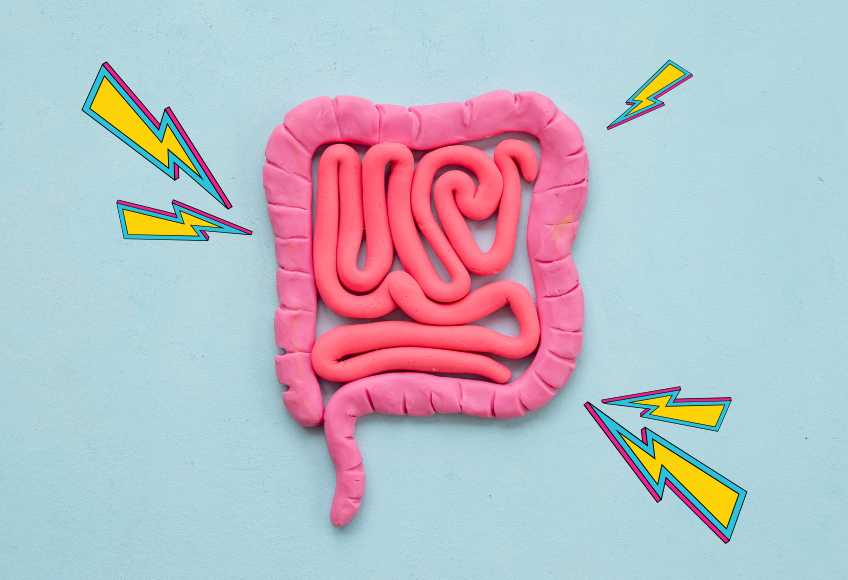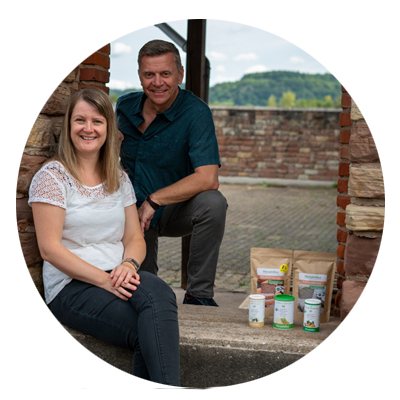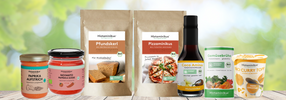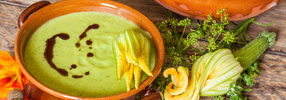
Chronic inflammatory bowel diseases
Diseases such as chronic inflammatory bowel diseases (CED), allergies, obesity, irritable bowel and metabolic disorders such as diabetes mellitus represent great health challenges of today's time. Their frequency increases worldwide.
In addition to genetic factors, changed lifestyle and environmental influences, the intestinal flora also plays an important role. Because the intestine forms an important barrier between the outside world and our inside of the body. The term microbioma means the entirety of all microorganisms living in the intestine, including bacteria, viruses, fungi and other unicellular organisms.
Share information about your brand with your Customers. Describe A Product, Make Announcements, Or Welcome Customers to your Store.
What is a chronic inflammatory bowel disease?
Chronic inflammatory bowel diseases are primarily expressed as Crohn's disease or ulcerative colitis. In some cases, mixed forms occur that cannot be clearly assigned to one of the two diseases. These diseases mainly affect the thin and large intestine and lead to more or less pronounced inflammation of the intestinal mucosa. In contrast to frequent irritable bowel syndrome, however, they go hand in hand with structural damage to the mucous membrane, which can range from small injuries to ulcers. The exact cause of these diseases has so far been unknown, which is why they are described as idiopathic. However, there are indications that various influences favor the inflammation in the digestive tract. These include a changed intestinal flora, genetic predispositions, environmental factors, smoking or taking antibiotics in childhood as well as incorrectly controlled immune reactions. Similar to other diseases that occur particularly frequently in western countries, several influences seem to work together. The ulcerative colitis can occur for the first time in very different ages, but most often between the ages of 30 and 40. Crohn's disease is usually shown for the first time at the age of 15 to 34. Both diseases affect men and women alike.
Share information about your brand with your Customers. Describe A Product, Make Announcements, Or Welcome Customers to your Store.
Crohn's disease and ulcerative colitis in detail
With Crohn's disease and ulcerative colitis, inflammation can occur at different areas in the intestine - sometimes outside the intestine, similar to allergies that can be shown in different ways.
▶ ️ Colitis ulcerative
Ulcerosa colitis is a chronic inflammation of the intestinal mucosa that affects the large intestine and can continuously spread up from the rectum (rectum). Depending on the extent, different forms are differentiated:
Practitis - inflammation only in the rectum
- Proktosigmoiditis - infestation of rectum and lower colon (most common form in diagnosis)
- Left -side colitis - inflammation extends to the left half of the intestine
- Pancolitis - the entire large intestine is affected
In rare cases, the last section of the small intestine (terminal ileum) can also be inflamed-one then speaks of "backwash-ilitis".
Symptoms and course
Ulcerosa colitis usually runs in slopes: phases with severe symptoms alternate with symptom -free times (remissions) that can take months to years. Sometimes the relapses merged directly.
Typical symptoms:
• Bloody or bloody, slimy diarrhea (especially fresh blood, especially in proctitis)
• Sudden, strong urge to chair (imperative stool urge)
• Abdominal pain and cramps (tenesmen)
• flatulence and sensitivity to pressure in the stomach
• Possibility of constipation (by cramps or stool attitude)
Heavy courses are accompanied by fever, weight loss and strong feeling of illness. In such cases, lack of fluids (dehydration), electrolyte disorders and protein deficiency can also occur. Especially among younger people, the disease can be shown beyond the intestine - for example through joint inflammation, eye problems or skin reactions.
Possible complications:
With heavy sparkling, life -threatening complications can occur:
• massive bleeding, especially with extensive inflammation
• Toxic megakolon-the colon widens heavily (more than 5-6 cm) and can no longer work properly. This can lead to an intestinal obstruction (ileus) or even a perforation (intestinal breakthrough). Symptoms are a bloated stomach and severe pain
• Increased colon cancer risk - the longer and large -scale the ulcerative colitis, the higher the risk of colon cancer, so regular preventive examinations are particularly important
Different forms of intensity:
• Recurring - relapses keep coming up, but there are long symptom -free phases
• Chronically active-the inflammation remains active, there are hardly any longer remissions
• Fulminant - a particularly severe and acute course with severe complaints and high complication risk
▶ ️ Crohn's disease
Crohn's disease is a chronic inflammation of the digestive tract, which can extend from the oral cavity to the rectum. Discontinuous inflammation is particularly typical, in which healthy and inflamed intestinal sections lie side by side. The disease usually runs in batches and often begins in youth or in young adulthood. She accompanies those affected for life, but can lose activity with increasing age.
The first signs include abdominal pain and diarrhea. In about 20 percent of the cases, intestinal bleeding occurs, while 10 to 40 percent anal fistulas occur, which can occur as painful inflammation in the anal area. Crohn's disease can affect the entire digestive tract, but occurs particularly often in the last section of the small intestine, the so -called terminal ileum, and in the large intestine. In almost half of those affected, the inflammation extends to both the thin and large intestine.
In addition to the intestinal complaints, further symptoms can occur outside the digestive tract:
• Weight loss and fever
• Anemia (anemia)
• Joint complaints
• Inflammation of the eyes and skin
Complications and possible consequences
Since Crohn's disease can penetrate deeply into the intestinal walls (transmural inflammation), various complications are possible:
- Bleeding - occur less frequently than with ulcerative colitis
- Fissures - painful cracks in the intestinal wall
- Fistulas - inflammatory connections that can spread into surrounding organs that can spread bladder or skin. Perianal fistulas are particularly common (over 54 % of cases)
- Abscesses - pus collections in the affected areas
- Strictures (narrowing) and intestinal locks (obstructions) - most often at the transition from the small intestine to the large intestine
- Rarer complications - toxic megacolon, intestinal breakdowns (perforations), colon cancer or other tumor -like new formations
The course of Crohn's disease is very individual and often not predictable. There are also three main forms here:
Recurring (intermittent) - about 40 % of those affected always experience relapses with symptom -free phases in between
- Chronic-active-the inflammation remains active permanently, without longer remission phases
- Fulminant - a particularly heavy and acute course with an increased risk of complications
In addition, there are various sub-forms of the chronic-active course of Crohn's disease. There is a steroid refractory course in about 20 percent of those affected, which means that despite intensive cortisone therapy, there is no improvement over at least six months. About 35 percent of the sick have a steroid-dependent course in which the symptoms occur immediately after an initial improvement as soon as the cortisone dose is reduced.
Diagnostic procedure
The diagnosis of Crohn's disease or ulcerative colitis is not easy because many different factors have to be taken into account. First of all, it is important to find out what the inflammation looks like in the intestine and how it shows itself in the blood.
The most important step towards diagnosis is an endoscopy in which the doctor looks into the intestine with a camera. A small tissue sample (biopsy) is also taken, which is then examined under the microscope. This can determine whether it is acute or chronic inflammation and whether it is Crohn or ulcerative colitis. In addition, other diseases, in particular infections, can also be excluded. Blood and chair tests are also made. For example, in the blood of inflammatory markers such as the C-reactive protein (CRP) or according to certain fabrics in the stool, which can indicate inflammation. These tests help the doctor check whether there is actually inflammation in the intestine. If the values are normal, it is also checked whether other causes of the symptoms are responsible, for example an irritable bowel, food intolerances or allergies. Sometimes earlier infections, such as salmonella infection, can still have an impact on the intestine and should also be considered.
It is also important to exclude infections, since certain germs can cause similar symptoms to a chronic inflammatory bowel disease. Therefore, the chair is often examined for possible pathogens.
Share information about your brand with your Customers. Describe A Product, Make Announcements, Or Welcome Customers to your Store.
Histamine and mast cells
Mast cells and histamine always play along when it comes to acute inflammation. In the case of inflammation in the intestine, certain messenger substances are released from immune cells that activate mast cells and other cells in the intestine that contain histamine. This gives more histamine. When the inflammation becomes stronger, things like bacteria or food can penetrate the intestine and stimulate the histamine tax even more. In severe cases, the histamine concentration not only increases in the intestine, but also in the blood, and the body excretes more dismantling products from histamine. Researchers have found that the amount of methylhistamine in the urine shows how active the disease is in Crohn's disease. But it is not yet clear how much histamine is produced by the bacteria in the patient's intestine and contributes to the total amount of methylhistamine.
This also explains why eating histamine -rich foods in Crohn's disease can worsen the disease. Even if histamine or mast cells are not the direct cause of the disease, there are still measures that can help reduce the negative effects of histamine. Although these measures are not specifically intended to treat the inflammation, they help to strengthen the intestinal barrier and reduce tissue swelling and damage, since histamine heats up the inflammation. The various histamine receptors in the intestine (such as H1, H2 and H4 receptors) show that histamine is important in the immune system of the intestine. With normal histamine amounts, it helps to regulate the body processes. However, if there is too much histamine in the body, it can lead to diarrhea, swelling, intestinal cramps and a misguided immune reaction.
With the ulcerative colitis, which affects the colon, the inflammation in the body is usually less pronounced than with Crohn's disease. The inflammation primarily affects the mucous membrane and can lead to ulcers and bleeding. The body reacts to this inflammation through a TH2-mediated immune reaction in which certain messenger substances such as interleukin 4, 5 and 13 are involved. These messenger substances are also involved in allergy sufferers and people with asthma and promote the formation of antibodies such as IGE. That is why ulcerative colitis is also referred to as the "asthma of the intestine". These immune reactions lead to higher histamine levels in the intestine, which can increase inflammation. Also outside the intestine, ulcerative colitis are more common in the ulcerative colitis or skin reactions that are connected to immediate Type-1 allergies.
Chronic inflammatory phase:
In the chronic inflammatory phase in Crohn's disease and ulcerative colitis, mast cells and other histamine -containing cells continue to be active, even after the acute inflammation has subsided. These cells remain anchored in the tissue of the affected intestinal areas and do not hike back. Even if the inflammation itself does not become active again, these mast cells can be reactivated by changes in the intestinal flora, certain foods or other lovely substances such as fruit acids. This then leads to symptoms such as irritable bowel, abdominal pain or a pressure -sensitive belly. Another problem with this is that mast cells can also react to stress - be it conscious or subconscious stress - and are therefore also activated. Such an activation of the mast cells disturbs the barrier function of the intestine and makes it more susceptible to relapses or infections. It can also increase symptoms.
Allergies:
In the case of chronic inflammatory bowel diseases such as Crohn's disease and ulcerative colitis, allergies often occur. Unfortunately, this topic is often not adequately observed in the treatment. With Crohn's disease, it is sometimes difficult to make a clear distinction between food allergy and the inflammatory intestinal problems. There are both quick and delayed reactions in the intestine that cause tissue damage that can look like the inflammation of Crohn's disease or ulcerative colitis. In the case of ulcerative colitis, a reduced ability to reduce histamine can also be observed, which causes additional symptoms. In some cases, the inflammation was able to decrease in the ulcerative colitis by recognizing a certain allergen. A big difference between food allergy and a chronic bowel disease is that the mucous membrane often heals quickly in the event of an allergy when the trigger falls away - this is not the case with chronic bowel diseases due to an unknown trigger.
Share information about your brand with your Customers. Describe A Product, Make Announcements, Or Welcome Customers to your Store.
Forms of therapy
There are now clear standards based on controlled studies. The treatment aims to inhibit the inflammatory reactions in the intestine because it is not possible to heal the cause. Standard medication include corticosteroids, aminosalicylates and Azathioprine. Medicines such as Ciclosporin or TNF antibodies are used for more difficult cases. In both illnesses, the possible side effects of the medication must be observed.
If you add newer antihistamines such as H1 or H2 blockers to drug therapy, the histamine effects can be neutralized faster and better. In a study, one could observe that patients needed less steroids (only 5-10 mg per day), had less pain and also occurred fewer allergy symptoms. But unfortunately antihistamines cannot completely stop the inflammation alone. In older studies, it has been found that cromoglicic acid or keto tables can help prevent inflammation because they stabilize the mast cells in the intestine. Certain probiotics work in this direction in some patients, but there are not yet many concrete data about how well they help in general. A very effective way of reducing inflammation and histamine effects is the intravenous administration of vitamin C (e.g. 2.5-7.5 g as a short infusion). This stimulates natural histamine mining in the body and at the same time helps to eliminate other inflammation substances. However, this is not an official therapy recommendation! All measures must be discussed with the attending doctor.
Operation is necessary for both diseases in certain cases. The operation is usually necessary for Crohn's disease. Frequent reasons are perforations, fistulas or the failure of drug therapy. Operation, on the other hand, is often healing in the ulcerative colitis, especially when the entire large intestine is removed (proctocolectomy). Early surgery may also be necessary for serious drug effects or in the case of malignant changes in the mucous membrane.
Share information about your brand with your Customers. Describe A Product, Make Announcements, Or Welcome Customers to your Store.
Image with text
👉🏼 L-glutamine complex³
With L-glutamine, Schisandrin-Chinensis extract and oliveblatte extract
👉🏼 HISTAPREVENT®
With vitamin C, B6 and zinc
👉🏼 The bacteria sensitive
8 different bacterial strains and L-glutamine
Collapsible content
SOURCES
- Book "Histamine intolerance" by Prof. Reinhart Jarisch

FROM THOSE AFFECTED FOR THOSE AFFECTED
We are Thomas and Michaela Zinser, founder of Histaminikus.
Because of the own histamine intolerance of Michaela and our son, we founded Histaminikus. The frustration does not find any suitable histamine food has spurred us to develop low -histamine food.
We would like to give you back a piece of quality of life. Feel free to look around with us.
Kind regards
Thomas and Michaela







